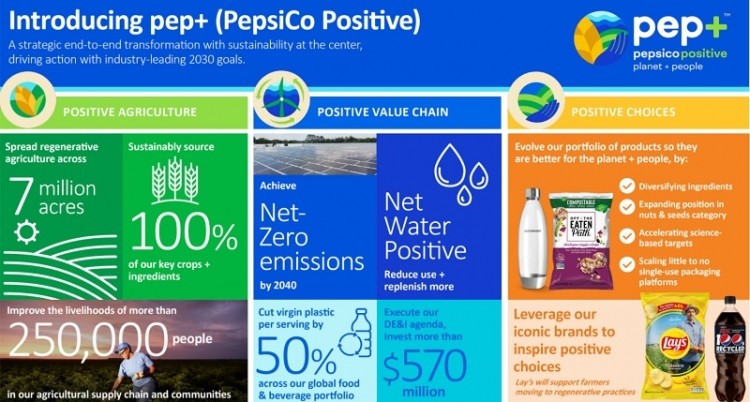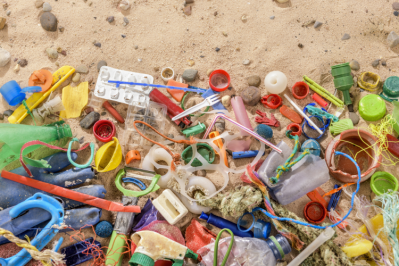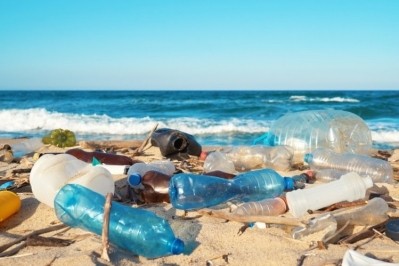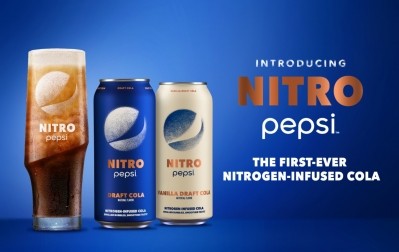PepsiCo more than doubles revenue growth with framework prioritizing sustainability

Touting revenue growth in 2021 more than twice that of the previous year at 9.5% and a staggering 12% earnings per share growth in the same year over 2% in 2020, Laguarta told attendees at the Consumer Analyst Group of New York’s conference late last week that PepsiCo’s strategic PepsiCo Way framework unveiled three years ago, including the September launch of pep+, have “meaningfully improved” the company’s performance.
“Over the past few years, we’ve delivered on average mid-single digit organic revenue growth in North America and high-singe digit organic revenue growth in our international markets, each of which represent a strong acceleration versus previous years,” Laguarta said.
Similarly, he noted, global organic revenue growth also accelerated across beverages 5.4% on average between 2019 and 2021 compared to only 1.6% on average between 2016 and 2018. Global organic revenue growth for convenient food also increased 6.7% compared to 4.7% in the same time periods.
In North America, the jump was even more significant with average organic revenue growth jumping to 5.3% between 2019 and 2021 from 1.5% in 2016 to 2018.
Pep+ ‘drives action and progress’ across three pillars
While many factors contributed to this success, including in North America increasing manufacturing capacity, continuous “consumer-centric innovation” and marketplace execution around the rest of world, Laguarta also called out efforts that are part of PepisCo’s still young pep+ program.
“Our investments in our people and products have also aided our success. We’ve invested to achieve a collaborative, inclusive and equitable workplace. … In addition, we’ve made good progress offering positive product choices to the consumer and we will continue our efforts to offer more choices with lower added sugar, sodium and saturated fat levels over time,” Laguarta said.
Both are central elements to PepsiCo’s pep+ program, which Laguarta said PepsiCo launched last fall as a way “to transform the way we create growth and value by operating within planetary boundaries and inspiring positive change for the planet and people in the global food system.”
He added, “Pep+ drives action and progress end-to-end across three key pillars: positive agriculture, positive value chain and positive choices.”
Under the first pillar, PepsiCo strives to increase regenerative agriculture practices, sustainably source key crops and ingredients and improve the livelihoods of people in its supply chain over the next eight years. Already, the company says, it is sourcing 100% of is potatoes in North America from sustainable farms.
Under the second pillar, PepsiCo strives to lower emissions, become net water positive and cut virgin plastic in its packaging. It also is investing more than $570m in its racial equity journey. On this front, the company says it is on track to have 50% women in managerial roles by 2025 having reached 43% as of 2021 and aims to increase Black and Hispanic managerial representation to 10%. In terms of adopting more sustainable packaging, PepsiCo’s Frito-Lay North America division introduced an industrially-compostable bag for select Off The Eaten Path products.
The third pillar is expanding positive choices, including for products that are better for people and the planet by incorporating more diverse ingredients, such as chickpeas, plant-based protein and whole grains.
More growth to come
Looking forward and continuing to keep pep+ “at the center of our strategic transformation,” Laguarta said PepsiCo plans to grow the business at compound annual rate of 4-5% in the next five years to capture 9% market share – a one percentage point increase worth $6m.
With regards to investments, sustainability is one of four priorities and will include funding for more sustainable packaging and plastics, decarbonization of operations and supply chain and enhanced water sustainability, he said.
The other, larger investment areas include operating necessities, growth and productivity, according to the company’s presentation.

















